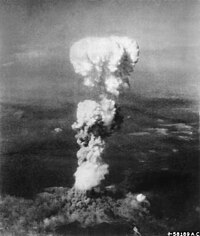Portal:Chemistry/Featured article/19
Uranium is a silvery metallic chemical element in the actinide series of the periodic table that has the symbol U and atomic number 92. The heaviest naturally occurring element, uranium is nearly twice as dense as lead and weakly radioactive. It occurs naturally in low concentrations (a few parts per million) in soil, rock and water, and is commercially extracted from uranium-bearing minerals such as uraninite (see uranium mining).
In nature, uranium atoms exist as uranium-238 (99.275%), uranium-235 (0.72%), and a very small amount of uranium-234 (0.0058%). Uranium decays slowly by emitting an alpha particle. The half-life of uranium-238 is about 4.5 billion years and that of uranium-235 is 700 million years, making them useful in dating the age of the Earth (see uranium–thorium dating, uranium–lead dating and uranium–uranium dating). Along with thorium and plutonium, it is one of the three fissile elements, meaning it can easily break apart to become lighter elements. This property of uranium-235 and to a lesser degree uranium-233 generates the heat needed to run nuclear reactors and provides the explosive material for nuclear weapons. Both uses rely on the ability of uranium to produce a sustained nuclear chain reaction. Depleted uranium (uranium-238) is used in kinetic energy penetrators and armor plating.
Research by Enrico Fermi and others starting in 1934 led to its use as a fuel in the nuclear power industry and in the first nuclear weapon used in war (see Little Boy and atomic bombings of Hiroshima and Nagasaki). An ensuing arms race during the Cold War between the United States and the Soviet Union produced tens of thousands of nuclear weapons that used enriched uranium and uranium-derived plutonium. The security of those weapons and their fissile material following the dissolution of the Soviet Union in 1991 along with the legacy of nuclear testing and nuclear accidents is a concern for public health and safety.

